.
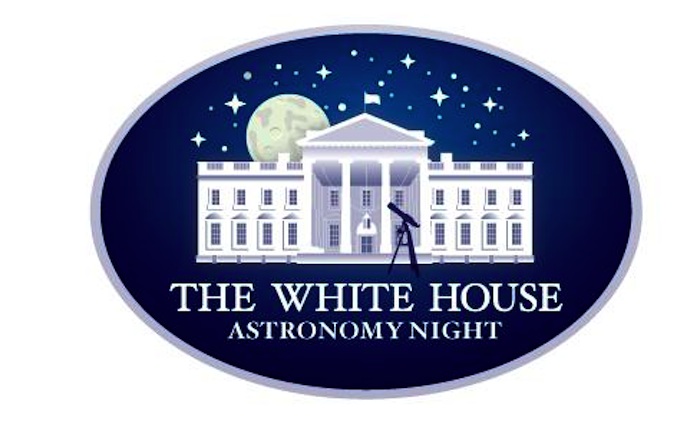
WASHINGTON, DC – Today, President Obama will host the second-ever White House Astronomy Night and highlight the importance of inspiring more girls and boys with the wonder of science and space. The event will bring together students, teachers, astronomers, engineers, scientists, and space enthusiasts for an evening of stargazing – a cherished hands-on learning activity, and one that will spark the imagination of aspiring space explorers, young and old.
As part of Astronomy Night, President Obama is also announcing new private-sector commitments to further his “Educate to Innovate” campaign to inspire and prepare more girls and boys – especially those from groups historically underrepresented in science, technology, engineering, and mathematics (STEM) – to excel in the STEM fields. The announcements being made today include, among others:
NASA will work with students and citizen scientists to scout targets for the James Webb Space Telescope, which will launch in 2018.
The Charles Stewart Mott Foundation and Noyce Foundation will work with more than 30 states and support more than 500,000 youth in afterschool STEM experiences.
More than 350 organizations and funders are announcing a goal to create 100 city and regional “STEM ecosystems” over the next five years.
Bayer and National PTA are launching a national effort to engage parents in 100,000 STEM experiences.
Boston is committing to a five-year campaign to give all middle-school students access to high-quality STEM experiences.
Details on White House Astronomy Night
The 2015 White House Astronomy Night is bringing together students, teachers, astronomers, engineers, scientists, and space enthusiasts of all ages for an opportunity to stargaze from the South Lawn of the White House.
Participants will also engage in hands-on science activities, including building model miniature satellites, peering at the planets and stars with different telescopes, and exploring samples of rocks from the Moon, Mars, and meteorites. Guests will also be able to meet astronauts and leading science communicators, and interact first-hand with presentations on cutting-edge space technologies. Additional information on the activities and exhibits at Astronomy Night can be found here.
In conjunction with White House Astronomy Night, schools, museums, National Parks and other institutions from more than 35 states are organizing their own astronomy nights across the country, in more than 80 separate events. In locations as diverse as Baltimore, MD; Twin Falls, ID; Grand Canyon National Park; San Juan, Puerto Rico; and even a school on a NATO base in Europe, people will gather to share the excitement of astronomy and explore the universe visible in their own backyards.
White House Astronomy Night is just the latest in a series of events that President Obama has hosted over the years to inspire students to pursue STEM education and increase opportunities for all Americans to develop careers in science, technology, and innovation-driven disciplines.
A Growing Community of Organizations is Answering the President’s Call to Action to Give More Students Access to High-Quality STEM Experiences
New Federal Efforts to Engage Students in Exciting Science Projects
NASA will work with students and citizen scientists to scout targets for the James Webb Space Telescope, which will launch in 2018. The National Aeronautics and Space Administration (NASA) is announcing a new effort to work with citizen scientists of all ages – students, citizen astronomers, space enthusiasts, and others – to search for moving objects in astronomical images, aiming to find the closest stars and brown dwarfs to the Sun. Finding these objects will teach us about how stars and planets form and yield important targets for the James Webb Space Telescope, which NASA expects to launch in 2018. Participants will study moving images from NASA’s Wide-field Infrared Survey Explorer space telescope, using the same technique that Clyde Tombaugh used to discover Pluto. The project will be a partnership between NASA’s Goddard Space Flight Center and the nearly 1.4 million-member Zooniverse citizen-science community.
NASA is announcing new awards to develop videos that excite the public about asteroid detection. NASA is committed to involving a broader community to help protect our planet from the possibility of hazardous asteroids. Through the Asteroid Grand Challenge, NASA is partnering with Tongal on a contest with a total of $20,000 in awards to seek creative videos that engage and excite the public about getting involved in NASA’s mission to find and characterize asteroids.
Growing State and Local Efforts
The Charles Stewart Mott Foundation and Noyce Foundation will work with more than 30 states and support more than 500,000 youth in after-school STEM experiences. The Charles Stewart Mott Foundation and Noyce Foundation are expanding their joint investments in STEM learning in after-school and summer learning programs to 31 states over the next two years. Through this partnership, 27 states are now engaged in efforts to connect communities, businesses, schools, museums and other STEM-rich institutions, and families and increase the number of quality STEM learning opportunities to excite, prepare, and inspire youth. The expanded efforts being announced today will support more than 500,000 youth, particularly in grades 4 through 8, to engage in hands-on learning that connects to the real-world. In support of this national push for a greater focus on STEM in after-school education, partner organizations for the Charles Stewart Mott Foundation and Noyce Foundation include:
The Afterschool Alliance, which will host more than 10,000 Lights on Afterschool events across this month, which will include a focus on STEM learning.
The Maine Mathematics and Science Alliance, which will provide after-school educators in rural settings access to STEM professional development, reaching 500 after-school providers and 18,000 youth.
Click2SciencePD, a national online resource to strengthen the skills of after-school and summer learning staff, which will deploy a new mobile app to help teach coaches and trainers how best to enhance the skills of front-line staff and volunteers who serve youth through extra-curricular programs. The app is expected to reach 5,000 coaches and trainers, who will in turn reach 75,000 front-line staff and volunteers serving over 1 million youth.
More than 350 local funders and organizations are announcing a goal to create 100 city and regional STEM networks over the next five years. Built on over a decade of research into successful STEM collaborations, the STEM Funders Network and 350 committed local funders and organizations are announcing a five-year effort to create 100 tight-knit local STEM networks – “STEM ecosystems” – that bring together collaborations between schools, extracurricular programs, the private sector, community-based organizations, youth and families, STEM professional associations, and STEM-focused institutions such as museums, science centers, and institutions of higher education. The multi-sector effort will focus on reducing the siloes between formal and informal education, better leveraging local STEM assets that a community may have, aligning with new developments such as the Next Generation Science Standards and with a focus on girls and underserved populations. The effort is launching with 27 inaugural communities, over $20 million in funding, and a goal of reaching over 600,000 teachers and students in its first three years. The 27 inaugural communities will participate in an upcoming workshop at the White House, which will be focused on convening and helping to expand a growing community of practice of local leaders who are expanding STEM opportunities in their communities.
Boston is committing to a five-year campaign to give all middle-school students access to high-quality STEM experiences. With the goal of creating a model that can be replicated nationally, Boston Mayor Martin J. Walsh, Boston Public Schools Superintendent Dr. Tommy Chang, and leaders from Vextex, the United Way of Massachusetts Bay and Merrimack Valley, Citizen Schools, and Boston After School & Beyond are announcing “BoSTEM,” a new multi-sector partnership to provide all Boston public middle-school students with a high-quality STEM learning experience by 2020. Today, these hands-on STEM learning opportunities are only available to six percent of Boston students through extracurricular programming. By 2020, BoSTEM hopes to reach 10,000 Boston Public Schools (BPS) middle-school students annually in a mix of both in-school and out-of-school settings. Organized by US2020, an organization focused on expanding high-impact STEM volunteering, BoSTEM will be a coalition of over a dozen high-performing nonprofits and a growing list of local corporations who are committing time, expertise, volunteers, and other support to help BPS close gaps in student learning, give students the chance to apply math and science skills in exciting, real-world contexts, and increase readiness and interest in the STEM fields.
Expanding Efforts to Get Parents and STEM Professionals Involved
Bayer and National PTA will launch a national effort to engage parents in 100,000 STEM experiences. Over the next 30 months, through support from the Bayer USA Foundation, National PTA will deliver 100,000 hands-on STEM experiences for kids. Research suggests that parents are the biggest influencer in a child’s college and initial career decisions, so National PTA will fill a critical gap in STEM education and outreach by engaging the entire family to cultivate the next generation of STEM professionals. The PTA campaign will include a focus on engaging underrepresented youth in STEM, including both girls and underrepresented minorities. Across America, local PTAs will support STEM events that bring together kids and parents to conduct guided hands-on experiments, and discover just how fun and cool science can be. In addition, PTA and Bayer will launch a free online series titled “STEM@Home” to support more hands-on STEM experiences that families can do conveniently at home, and which builds upon the foundation of Bayer’s long-standing “Making Science Make Sense ” program. Bayer is also partnering with Tickets for Kids Charities and committing to donate up to 25,000 hands-on science experiences, such as a visit to a science center. Both initiatives are part of Bayer’s pledge to provide 1 million hands-on science experiences by 2020.
US2020 will help more teachers recruit STEM professionals who want to volunteer. US2020 and Nepris are announcing a new national partnership that will connect US2020’s network of corporate and nonprofit partners with Nepris, a cloud-based platform that makes it easy for teachers to connect with industry professionals to bring real-world relevance to lessons. The project, which will go live this November, will connect thousands of STEM professionals with classroom teachers throughout the country with the goal of increasing exposure to STEM education and career pathways for traditionally underrepresented students. National partners of the effort include Alcoa Foundation, CA Technologies, Chevron, Cisco, Cognizant, Discovery, Raytheon, SanDisk, TCS, and Texas Instruments.
Inspiring More Students into Science with Astronomy and Space
As part of its efforts to get more students excited about science, Discovery is announcing plans to premiere an all-new documentary, TELESCOPE. Discovery is announcing plans to premiere an all-new documentary, TELESCOPE, which will air as part of a special weekend of science programming on both Discovery Channel and Science Channel next year. The new documentary will be part of Discovery Communications, overall sustained commitment across its brands to promote student interest in science, technology, engineering, and mathematics (STEM), including Science Channel and Discovery Education's Support our Science (S.O.S) initiative that’s designed to ignite students’ curiosity while providing educators with the means to build skills and knowledge in the areas of STEM. TELESCOPE, which premieres in early 2016, will take viewers behind the making of the James Webb Space Telescope, the latest innovation in the tool’s 400-year history. TELESCOPE will take viewers into the high-stakes mission of building the Webb Telescope, with unprecedented access to the people and technologies that power its creation. TELESCOPE will also reveal numerous firsts, including the testing of never-before-seen technologies, as the process and allure of the unknown and the deep and abiding drive for greater understanding puts us face to face with the fundamental questions about our origins and universe’s beginning. In addition, as part of Discovery's S.O.S. initiative, students at select elementary schools will receive special, interactive assembly, such as the an appearance Dr. Hakeem Oluseyi, astrophysicist and star of Science Channel's Outrageous Acts of Science, as well as a customized STEM education program to support teachers and engage students in the power of STEM.
Eight of the world’s leading observatories are partnering to offer Hawai‛i residents over the age of 16 free, guided tours of their facilities. With the goal of inspiring a passion for astronomy among Hawai’i’s students, teachers, and families, the 'Imiloa Astronomy Center is partnering with eight of the world’s leading observatories to offer local Hawai‛i residents over the age of 16 free, guided tours into the eight observatories. The partner observatories are W.M. Keck Observatory, Gemini Observatory, Canada-France-Hawaii Telescope, Subaru Telescope, NASA Infrared Telescope Facility, James Clerk Maxwell Telescope, Harvard-Smithsonian Center Submillimeter Array, and, in the future, the Thirty Meter Telescope. Starting as early as November 2015, the partnership will on a monthly basis register participants, provide free transport to and from the summit, present cultural insights, offer a free guided tour at least one of the observatories, and introduce the participants to world-class astronomers.
The Museum of Science Fiction, Cornell University, and NASA Space Grant consortia grantees are announcing a competition for high-school students to get CubeSat projects they develop launched into space. Based on the belief that science fiction, curiosity, and project-based learning holds educational value for all ages, the Museum of Science Fiction, Cornell University, and universities in NASA’s Space Grant program are announcing a CubeSat competition that will be open to all high-school students. Challenging students to create the most compelling research design proposals within a CubeSat’s limitations, the goal of the competition is to both infuse agile and innovative ideas into the space sector, and to get more students inspired to tinker with the technologies that democratize access to space. Eight prizes will be awarded and the winners will have their mission design proposal funded and built, and will have the opportunity to apply to NASA’s CubeSat Launch Initiative for a launch. Data collected from the missions will be shared with participating schools and other research organizations for analysis. Winners will be awarded at Escape Velocity event in Washington, D.C., next year.
From games to DIY astronomy, organizations are announcing creative new efforts to get more students and adults excited about science and space. Various organizations are announcing an array of pilots, gatherings, and projects that will engage students and adults in new ways, from conducting citizen science, to creating videos, to making their own telescopes.
The Center for Gaming Science at the University of Washington, and the Allen Institute for Brain Science, with support from the National Science Foundation (NSF), are announcing plans to work with a growing community of citizen neuroscientists to develop a game whose ultimate goal is to produce a “periodic table of the neurons.” The effort will use crowd-sourcing to accelerate the discovery of 3-dimentional neuronal structures, while getting students and other non-“expert” citizens who participate excited about discovering some of the mysteries of the human brain.
Digital Promise will host a “see it in action” national convening in Pittsburgh on STEM and Maker learning with more than 70 innovative school district leaders representing 3 million students. Participants will have the opportunity to tour the Elizabeth Forward, Avonworth, and South Fayette school districts in the Pittsburgh area, and to see first-hand the STEM, computational thinking, and maker-learning programs at schools in these districts.
Infamous Robotics, with support from ENSCO, will launch a new student competition called, “Start your Own Robotics Company,” which will give students a new way to immerse themselves in the world of autonomous systems, robotics, assistive-robotics applications, and sensor applications.
Maker Camp, produced by Maker Media, a free-to-join community of kids making and sharing hands-on projects focused on STEM, arts, and design, is expanding from its summer programming to become a year-round after-school program. In conjunction with White House Astronomy Night, Maker Camp will highlight fun, space-friendly projects that anyone can make, like rockets, rainbow spectrometers, galaxy slime, interplanetary costumes, and more.
Maker Ed, with support from Chevron, will build out a professional development category of its online Resource Library. With the goal to reach 20,000 teachers in the first year, the resource will support the work of formal and informal educators who strive to increase their ability to nurture the curiosities and capabilities of the youth and communities in STEM learning.
NCWIT and ACM-W, with support from Google.org, will create a national network of women-in-computing groups that exist on college campuses. These campus hubs will be offered startup grants, amplification grants, and moonshot grants to grow their chapters, access the national network, and have the resources to launch strategic initiatives on their campuses.
Squad, the developers of the game Kerbal Space Program, will launch a public campaign through Kerbal Space official channels for a girls-focused video production contest in early 2016, which will reach Kerbal Space’s user base of more than 1 million people. The contest will highlight incredible feats in space travel by women, and demonstrate how girls and women are solving some of the hardest challenges in astrophysics and space exploration. Winners of the campaign will earn prizes for themselves and their schools.
TIES Teaching Institute for Excellence in STEM, Fab Foundation, and partners are announcing a pilot program to give students the hands-on design and engineering experience of building their own telescopes. The project will infuse a DIY engineering spirit into students’ fascination with space, working with interested Fab Labs in the United States to design and implement curricula and instructional modules for students of a wide age range.
The Yale Undergraduate Aerospace Association (YUAA), working with local K-12 students, is announcing plans to build an Automated Optical Telescope over the next year to explore the night sky. This telescope will be automated using software written by the team, motorized to track celestial objects as they progress across the sky, and equipped to take long-exposure photographs of deep-field objects. YUAA students are also working on a prototype model of a CubeSat that could transmit photos of the Earth taken from an on-board camera.
Ongoing Momentum and Progress Updates by Organizations Participating in the President’s Educate to Innovate Initiative
Expanding the campaign to prepare 100,000 excellent STEM teachers. Responding to the President’s call to action to train 100,000 excellent STEM teachers, 100Kin10 is a national network coordinating and accelerating efforts to bring 100,000 new, excellent STEM teachers into schools by 2021. Building on its success raising $80 million in philanthropic funds over the past four years, in the past month 100Kin10 has launched its fourth philanthropic fund, with new supporters including The APS Foundation and Simons Foundation, and renewed pledges from Carnegie Corporation of New York and the Leonetti O’Connell Family Foundation. 100Kin10 has also opened its annual nominations season for organizations interesting in joining the network which, to date, includes more than 230 partner organizations that have made over 350 commitments to help train and retain STEM teachers. In addition, 100Kin10 is tapping the expertise of its network of partners and experts, including EdPolicy Works, to expand ways of identifying excellent STEM teaching in K-12 classrooms to better support the development and ongoing improvement of excellent STEM teachers.
Growing the Grand Challenge Scholars Program. At the White House Science Fair in March, 122 U.S. engineering schools announced plans to educate a new generation of engineers expressly equipped to tackle some of the most pressing issues facing society in the 21st century. Since then, the National Academy of Engineering Grand Challenge Scholars Program has received enough new applications to be on track for close to a 50 percent increase in approved programs by the end of the year.
A partnership of youth-serving organizations is expanding its efforts to incorporate STEM learning to 12 communities. As part of the 2015 White House Science Fair, four of the nation’s largest youth development organizations - Boys & Girls Clubs of America, National 4-H Council, YMCA of the USA, and Girls, Inc. – announced a multi-year partnership, “Imagine Science,” to jointly tackle the challenge of engaging underrepresented youth in STEM learning. Based upon the initial pilot’s success, the Imagine Science partners have now committed to a second-stage pilot to include 12 total communities across the nation by 2017, after which the program will scale throughout the partner organizations’ national networks – which, combined, reach more than 110,000 local affiliate sites. The pilots involve expert staff from across the organizations, with the goal of designing STEM programs for times and places where options are typically few.
Infosys Foundation USA, a non-profit focused on bridging the digital divide in America, is launching the Infy Makers program. The program will grant up to $1 million to support makers with innovative projects and support the creation of makerspaces in schools, libraries, and other community organizations. Infosys is also partnering with Maker Ed to provide professional development and resources to 100 educators from grantee organizations. Infosys Foundation USA is also announcing new grants to GirlsWhoCode, ScriptEd, and CodeNow. These will provide more than 6,000 students from groups historically underrepresented in science, technology, engineering, and mathematics (STEM) with opportunities to gain critical computer-science and coding skills through more than 500 clubs and camps across the United States.
Brit + Co is supporting the #IAMCREATIVE Foundation with a grant to help equip women with the resources and expert knowledge they need to execute an ambitious creative project or endeavor.
Marking Six Years of Discovery and Accomplishment in Space
This week, NASA is celebrating Exoplanet Week, which celebrates the remarkable discoveries of exoplanets that have been made in recent years. With the recent discovery of Kepler 452b, “Earth’s bigger, older cousin,” worlds that used to be considered science fiction are drawing closer to fact. Indeed, just over 20 years ago, it was uncertain whether there were any other planets outside our solar system that orbited other stars. Now, astronomers believe there is at least one distant world for every star in the sky.
Because of this Administration’s investments, which include the Transiting Exoplanet Survey Satellite and the James Webb Space Telescope (both scheduled to launch in the next few years), NASA’s fleet of powerful observatories will peer even deeper into the universe. In addition, the Administration’s investments over past six years are yielding progress across the President’s outlined space priorities: These include:
Journey to Mars. The Administration’s investments in space technology development and the Asteroid Redirect Mission are key to developing the capacity for a future human mission to Mars. NASA’s current science missions are already providing important insight into the Red Planet. For example, the roving Mars Science Lab, Curiosity, which landed in August 2012, continues to produce a scientific treasure trove of data providing new understanding of the history of that planet’s surface, including definitive proof that water once flowed there. Also, the MAVEN mission, which began orbiting Mars last September, is providing unprecedented insights into the history of the Martian atmosphere.
Space Technology. Investments in advanced technologies have improved U.S. capabilities in areas that could revolutionize exploration missions and help U.S. industry. For example, improved deployable space solar arrays, demonstrated with funding from the Space Technology Mission Directorate, are now being leveraged by U.S. commercial satellite manufacturers and NASA missions.
Earth Science and Climate. Today, NASA is launching a new website so the world can see images of the full, sunlit side of the Earth every day. The images are taken by a NASA camera one million miles away on the Deep Space Climate Observatory (DSCOVR), a partnership between NASA, the National Oceanic and Atmospheric Administration (NOAA), and the U.S. Air Force. In addition, NASA has successfully launched five Earth-science missions in the past 20 months.
International Space Station. The International Space Station will mark 15 years of humans continuously living in space on November 2. Orbiting 250 miles above the Earth, astronauts aboard the station are conducting research not possible on the ground, like the one-year mission with astronaut Scott Kelly. The space station also is facilitating the growth of a robust commercial market in low-Earth orbit for research, technology development, and crew and cargo transportation.
Commercial Space Industry. NASA’s support has helped to create a burgeoning U.S. private space sector. Two private providers, SpaceX and Orbital ATK, are delivering cargo to the ISS, and contracts were signed late last year with SpaceX and Boeing for transport of astronauts to the ISS on U.S. rockets by 2017. In addition, NASA has named four astronauts – all of whom will be participating in the Astronomy Night event – to train to fly orbital flight tests in Boeing's CST-100 Starliner and SpaceX’s Crew Dragon spacecraft.
.
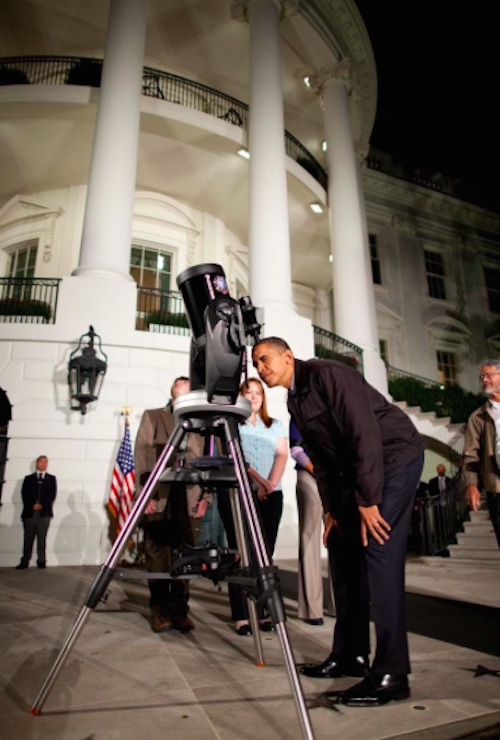
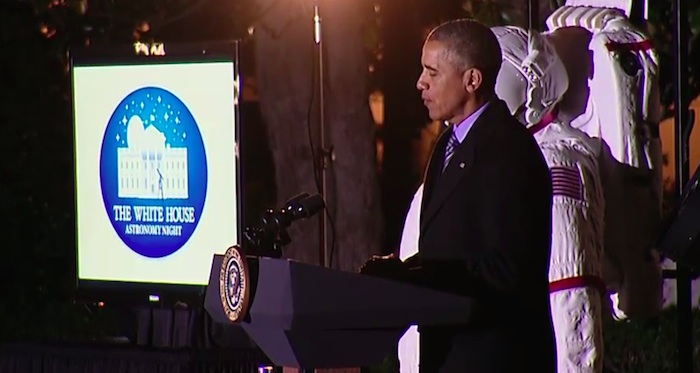
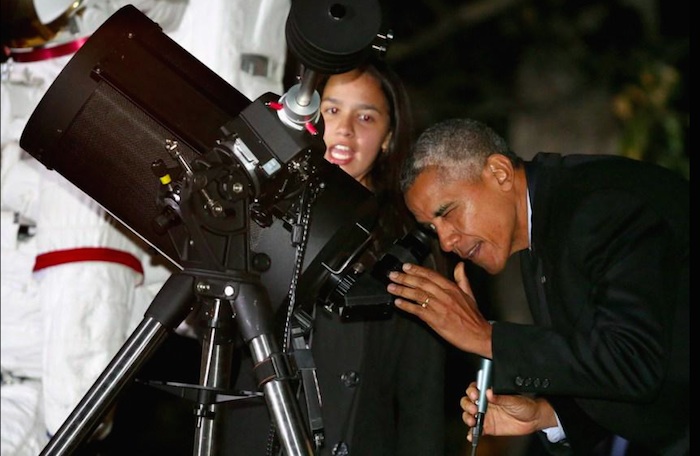
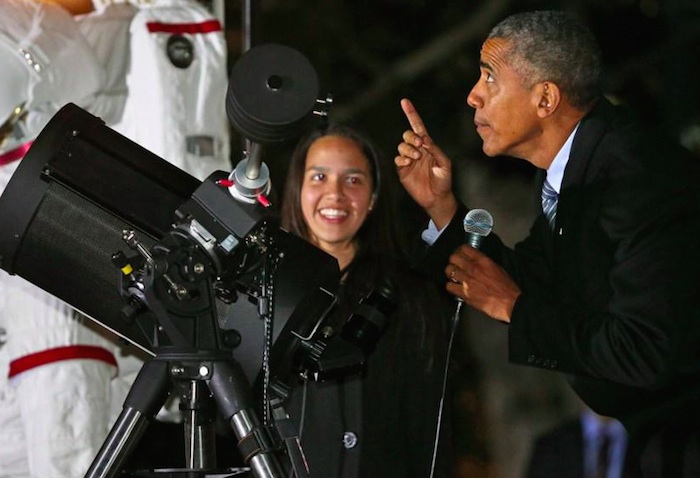
Quelle: the WHITE HOUSEPRESIDENT BARACK OBAMA
4212 Views
